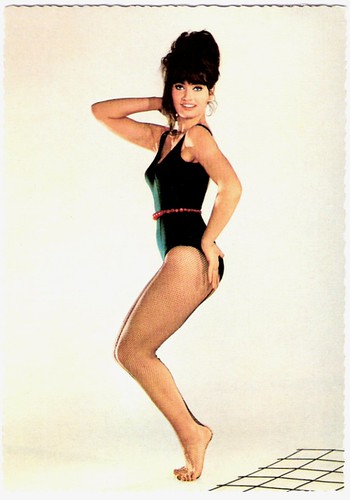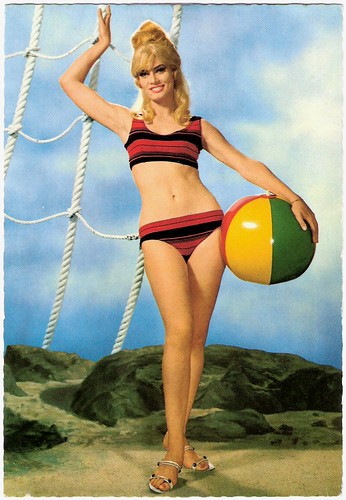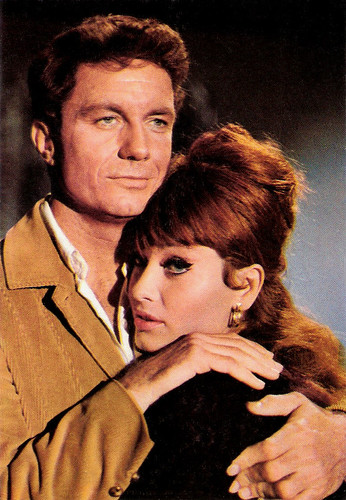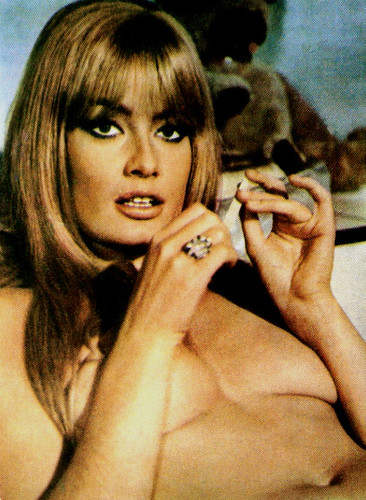Curvaceous Austrian actress Marisa Mell (1939-1992) became a cult figure of 1960s Italian B-films. Her most famous role is criminal mastermind Eva Kant in Mario Bava’s Diabolik (1968).

German postcard by Krüger, no. 902/349. Photo: Bernard of Hollywood.

German postcard by Krüger, no. 902/407. Photo: Lothar Winkler.
Marisa Mell was born as Marlies Theres Moitzi in Graz, Austria, in 1939. She was raised by her schoolteacher mother.
In 1954, she appeared in an uncredited part in the film Das Licht der Liebe / The Light of Love (Robert A. Stemmle, 1954) starring Paula Wessely. Marlies left Graz to study acting at the Max-Reinhard-Seminar in Vienna, where she graduated together with Senta Berger, Heidelinde Weis and Erika Pluhar.
Her beauty and natural talent gave her plenty of stage presence. She changed her name to Marisa Mell and left Austria for Germany in the late 1950s. A string of minor roles followed in films like Das Nachtlokal zum Silbermond / The Night Bar At the Silvery Moon (Wolfgang Glück, 1959), Am Galgen hängt die Liebe / Love Hangs at the Gallow (Edwin Zbonek, 1960) and the Edgar Wallace adaptation Das Rätsel der roten Orchidee / Puzzle of the Red Orchid (Helmut Ashley, 1962) with Christopher Lee.
She played her first lead in Venusberg (Rolf Thiele, 1963). Just now, her career began to escalate, and she was involved in a nasty car accident in France. For six hours, she lay unconscious, unaware that she had nearly lost her right eye. The disfigurement extended to her lip as well. She spent two years undergoing plastic surgery. No damage remained in her face, except for a distinctive curl of her upper lip, but, according to her fan ‘Blundering Man’ at the blog Cult Sirens, this added “even more charm to her already attractive features.”
Following her recovery, Mell headed for Britain, where she easily played the role of a film star in French Dressing (1964), the first feature of Britain's bad boy Ken Russell. She next made Masquerade (Basil Dearden, 1965) with Cliff Robertson. She turned down a seven-year Hollywood contract, saying that while the payment would have been great, "the contract was a whole book. I think that even to go to the toilet I would have needed permission." Instead of Hollywood, she chose Rome.

German postcard by ISV, Sort. 16/6.

German postcard by Fred W. Sander-Verlag, Minden (Kolibri-karte), no. 1942.
Marisa Mell started her Italian film career with the Oscar-nominated comedy Casanova 70 (Mario Monicelli, 1965) starring Marcello Mastroianni. Among her co-stars were other ravishing beauties like Michèle Mercier and Virna Lisi.
The following year, she played one of the leads in the spy thriller New York chiama Superdrago / New York Calls Super Dragon
(Calvin Jackson Padget, aka Giorgio Ferroni, 1966). Mell's beauty and flair for comedy helped bring her career into full swing.
German postcard by Krüger, no. 902/349. Photo: Bernard of Hollywood.

German postcard by Krüger, no. 902/407. Photo: Lothar Winkler.
Nasty car accident
Marisa Mell was born as Marlies Theres Moitzi in Graz, Austria, in 1939. She was raised by her schoolteacher mother.
In 1954, she appeared in an uncredited part in the film Das Licht der Liebe / The Light of Love (Robert A. Stemmle, 1954) starring Paula Wessely. Marlies left Graz to study acting at the Max-Reinhard-Seminar in Vienna, where she graduated together with Senta Berger, Heidelinde Weis and Erika Pluhar.
Her beauty and natural talent gave her plenty of stage presence. She changed her name to Marisa Mell and left Austria for Germany in the late 1950s. A string of minor roles followed in films like Das Nachtlokal zum Silbermond / The Night Bar At the Silvery Moon (Wolfgang Glück, 1959), Am Galgen hängt die Liebe / Love Hangs at the Gallow (Edwin Zbonek, 1960) and the Edgar Wallace adaptation Das Rätsel der roten Orchidee / Puzzle of the Red Orchid (Helmut Ashley, 1962) with Christopher Lee.
She played her first lead in Venusberg (Rolf Thiele, 1963). Just now, her career began to escalate, and she was involved in a nasty car accident in France. For six hours, she lay unconscious, unaware that she had nearly lost her right eye. The disfigurement extended to her lip as well. She spent two years undergoing plastic surgery. No damage remained in her face, except for a distinctive curl of her upper lip, but, according to her fan ‘Blundering Man’ at the blog Cult Sirens, this added “even more charm to her already attractive features.”
Following her recovery, Mell headed for Britain, where she easily played the role of a film star in French Dressing (1964), the first feature of Britain's bad boy Ken Russell. She next made Masquerade (Basil Dearden, 1965) with Cliff Robertson. She turned down a seven-year Hollywood contract, saying that while the payment would have been great, "the contract was a whole book. I think that even to go to the toilet I would have needed permission." Instead of Hollywood, she chose Rome.

German postcard by ISV, Sort. 16/6.

German postcard by Fred W. Sander-Verlag, Minden (Kolibri-karte), no. 1942.
Sexy criminal mastermind
Marisa Mell started her Italian film career with the Oscar-nominated comedy Casanova 70 (Mario Monicelli, 1965) starring Marcello Mastroianni. Among her co-stars were other ravishing beauties like Michèle Mercier and Virna Lisi.
The following year, she played one of the leads in the spy thriller New York chiama Superdrago / New York Calls Super Dragon
In 1967, she was cast by American producer David Merrick for the title role in the Broadway musical 'Mata Hari'. The director was Vincente Minelli, and her co-star was
Marisa returned to Italy and starred as Eva Kant in Diabolik / Danger: Diabolik (1968), directed by Mario Bava and produced by Dino De Laurentiis. The film was based on one of the longest-running and most successful Italian comic strips. Eva Kant is the sexy and mysterious sidekick to antihero Diabolik, a criminal mastermind who finds great pleasure in leading the authorities on various wild goose chases.
According to Blundering Man at Cult Sirens, Bava “had preferred her over Catherine Deneuve, no less, as he was searching for a ‘comic book’ style of beauty. Danger: Diabolik remains a successful adaptation of a comic on the big screen (and maybe the ultimate role for stolid star John Philip Law), and the various superhero costumes could've been an inspiration for Tim Burton's Batman.”

Small Romanian collector card by Casa Filmului Acin. Photo: publicity still for Der letzte Ritt nach Santa Cruz / The Last Ride to Santa Cruz (Rolf Olsen, 1964) with Mario Adorf and Thomas Fritsch.

Italian postcard. Photo: Dear Film. Publicity still for Masquerade (Basil Dearden, 1965) with Cliff Robertson.

Small Romanian collectors card by Cooperativa Fotografica. Photo: publicity still for Che notti ragazzi! / That Night Guys! (Giorgio Capitani, 1966).

Yugoslav postcard by Cik Razglednica.
Notorious cocaine scandal
For Marisa Mell, then started the best and most productive years of her career. She worked mainly in Italy, with occasional stops in France and Spain. In 1969, she played the challenging dual role of an asthmatic, dying wife and a seductive stripper in Una sull'altra / One on Top of the Other (Lucio Fulci, 1969). That year, she had a miscarriage. The father of the child was Pier Luigi Torri, with whom she lived for about three years. During that time, Torri produced one of Marisa's better (yet unsuccessful) films, Senza via d'uscita / No Way Out (Piero Sciumé, 1970), co-starring Philippe Leroy. Torri had to leave Italy in 1971 after a notorious cocaine scandal to avoid prison.
Another interesting film is Sette orchidee macchiate di rosso / Seven Blood-Stained Orchids (Umberto Lenzi, 1971) starring the father of Hollywood hunk Antonio Sabato, Antonio Sabato Sr. In 1975, she appeared in the Diana Ross musical Mahogany (Berry Gordy, 1975). In Some Like It Cool / Casanova & Co. (Franz Antel, 1977). Marisa was joined by Tony Curtis, Marisa Berenson, Sylva Koscina and Britt Ekland. In between, Marisa found the time to pose nude for the Italian version of Playboy in the November 1976 issue.
As Mell got older, femme fatale roles in good films were no longer offered to her. In the 1980s, she appeared in more and more obscure B-films, the majority being soft sex comedies, which were distributed only in Europe. In the late 1980s, the American television show Mystery Science Theater 3000 brought the actress to a new generation of B-film viewers when Danger: Diabolik was featured in an episode in 1988. The show also spoofed another of her films, New York chiama Superdrago / New York Calls Super Dragon.
She wrote her autobiography, 'Coverlove', which was published in Vienna in 1990. That same year, she appeared in Quest for the Mighty Sword / Ator III: The Hobgoblin (Joe D'Amato, 1990), co-starring strongman Eric Allan Kramer and Laura ‘Black Emmanuelle’ Gemser. Her last film appearance was in the comedy I Love Vienna (Houchang Allahyari, 1991).
In Vienna, Marisa Mell passed away from throat cancer in 1992. She was only 53 and died in poverty. Only a few friends attended her funeral. She had been married twice, to Henri Tucci and to Espartaco Santoni. In 1996 her best friend Erika Plughar published 'Marisa, Rückblenden einer Freundschaft' (Marisa, Flashbacks of a Friendship).
Trailer of Das Rätsel der roten Orchidee / Puzzle of the Red Orchid (1962). Source: RialtoFilm (YouTube).
Trailer for Diabolik / Danger: Diabolik (1968). Source: Danios12345 (YouTube).
Scene from Diabolik / Danger: Diabolik (1968). Source: Agodipino (YouTube).
Marisa Mell in Una sull'altra / One on Top of the Other (1969). Source: Stranevisione (YouTube).
Sources: Mirko di Wallenberg (Marisa Mell blog), Blundering Man (Cult Sirens - Now defunct), Brian J. Walker (Brian’s Drive-In Theater), Time (Page now defunct), Wikipedia and IMDb.
This post was last updated on 29 July 2025.
No comments:
Post a Comment